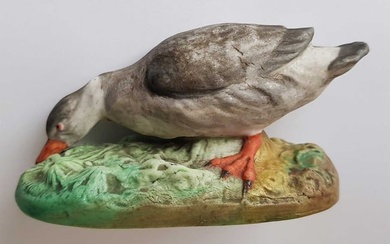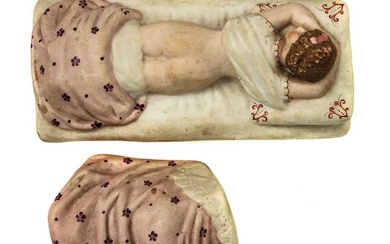Antique Imperial Russian Gardner Kuznetsov Factory
Antique Imperial Russian Gardner Kuznetsov Factory Design Porcelain Tea set.Ca. 1870 - 1890 according to the mark. Sizes, height/diameter: 12 cups, 50x80 mm.; 12 saucers, 20x142 mm.; 1 tea-pot, 150x115 mm.; 1 sugar-bowl, 100x150 mm.; 1 milk jug, 110x170 mm.; 1 serving dish, 40x325 mm.; 1 cake stand, 155x215 mm.; 1 shaped tray, 295x185 mm.; 18 butter bowls, 20x94 mm.; 18 little dishes, 250x163 mm. Restoration on a cup and crack on a cup, otherwise very good condition.
Further Details
A Russian porcelain tea set for twelve persons, with fine decoration of bunches of purple and gold vine leaves. Nicely marked on the bottom by Gardner in red in under glaze. The set includes a twelve cups with saucers, a tea-pot, a sugar-bowl with cover, a milk jug, a cake stand, a serving dish, a rectangular shaped tray, eighteen butter bowls, eighteen little dishes.Founded at Verbilki, near Moscow, by the Englishman Francis Gardner in 1766, and known for its hard paste porcelains, the Gardner factory served as important competition for the Imperial Porcelain Factory, spurring artists at both institutions to produce more complicated wares in terms of both form and decoration. One of two porcelain works in Russia during the 18th century, The factory was situated in the Gjelsk region where local clay, which proved suitable for porcelain, could be used. Gardner started with a German manager called Gattenberg, who later joined the Imperial Factory, and he employed a well-known German painter, Kestner. But these and other foreigners taught many Russian craftsmen, principally serfs, who gradually replaced them, as soon as they had mastered the various techniques; so that the number of foreigners employed in key positions steadily diminished in course of time. The factory was operated by the family for three generations until 1891, when it was taken over by Kusnetzoff.Gardner porcelain had a wide variety of marks in the 140 years of its existence. Different shapes of the Latin letter G, painted underglaze in blue or black, were most frequent in the late eighteenth and early nineteenth centuries. Occasionally the mark is similar to the Meissen crossed swords with a star. In the first quarter of the nineteenth century the full name of the factory, impressed either in Cyrillic or Latin characters, becomes more frequent. In the second half of the nineteenth century the mark is usually the Moscow St George and Dragon crest, surrounded by a circle, bearing the full name of the factory, at first impressed, and later painted in green or red. In the last decades of the factory’s existence the double-headed eagle was added to the design, and this elaborate mark continued after the Gardner firm had been absorbed by Kuznetsov.For inquiries, detailed condition report and additional images please mail to info@badoemart.it.
Estimate
Time, Location
Auction House
Antique Imperial Russian Gardner Kuznetsov Factory Design Porcelain Tea set.Ca. 1870 - 1890 according to the mark. Sizes, height/diameter: 12 cups, 50x80 mm.; 12 saucers, 20x142 mm.; 1 tea-pot, 150x115 mm.; 1 sugar-bowl, 100x150 mm.; 1 milk jug, 110x170 mm.; 1 serving dish, 40x325 mm.; 1 cake stand, 155x215 mm.; 1 shaped tray, 295x185 mm.; 18 butter bowls, 20x94 mm.; 18 little dishes, 250x163 mm. Restoration on a cup and crack on a cup, otherwise very good condition.
Further Details
A Russian porcelain tea set for twelve persons, with fine decoration of bunches of purple and gold vine leaves. Nicely marked on the bottom by Gardner in red in under glaze. The set includes a twelve cups with saucers, a tea-pot, a sugar-bowl with cover, a milk jug, a cake stand, a serving dish, a rectangular shaped tray, eighteen butter bowls, eighteen little dishes.Founded at Verbilki, near Moscow, by the Englishman Francis Gardner in 1766, and known for its hard paste porcelains, the Gardner factory served as important competition for the Imperial Porcelain Factory, spurring artists at both institutions to produce more complicated wares in terms of both form and decoration. One of two porcelain works in Russia during the 18th century, The factory was situated in the Gjelsk region where local clay, which proved suitable for porcelain, could be used. Gardner started with a German manager called Gattenberg, who later joined the Imperial Factory, and he employed a well-known German painter, Kestner. But these and other foreigners taught many Russian craftsmen, principally serfs, who gradually replaced them, as soon as they had mastered the various techniques; so that the number of foreigners employed in key positions steadily diminished in course of time. The factory was operated by the family for three generations until 1891, when it was taken over by Kusnetzoff.Gardner porcelain had a wide variety of marks in the 140 years of its existence. Different shapes of the Latin letter G, painted underglaze in blue or black, were most frequent in the late eighteenth and early nineteenth centuries. Occasionally the mark is similar to the Meissen crossed swords with a star. In the first quarter of the nineteenth century the full name of the factory, impressed either in Cyrillic or Latin characters, becomes more frequent. In the second half of the nineteenth century the mark is usually the Moscow St George and Dragon crest, surrounded by a circle, bearing the full name of the factory, at first impressed, and later painted in green or red. In the last decades of the factory’s existence the double-headed eagle was added to the design, and this elaborate mark continued after the Gardner firm had been absorbed by Kuznetsov.For inquiries, detailed condition report and additional images please mail to info@badoemart.it.





